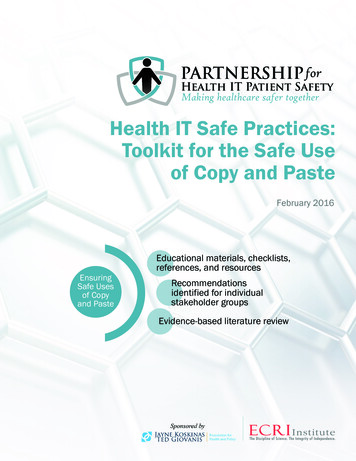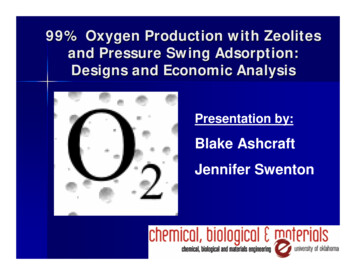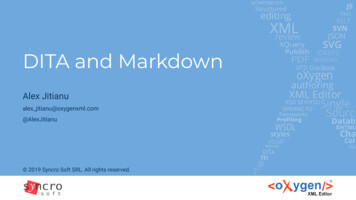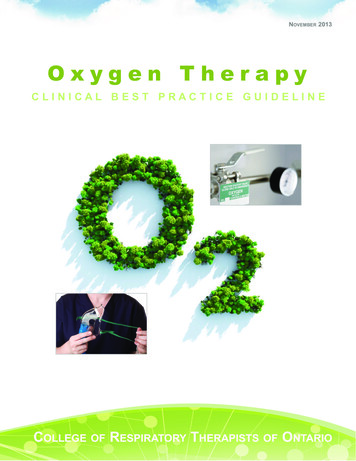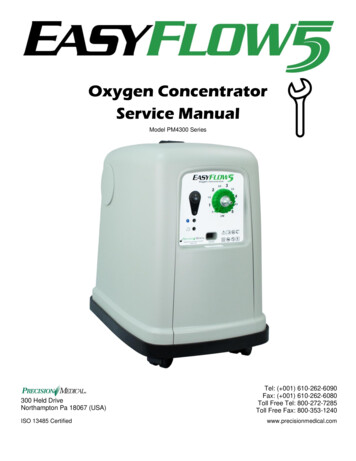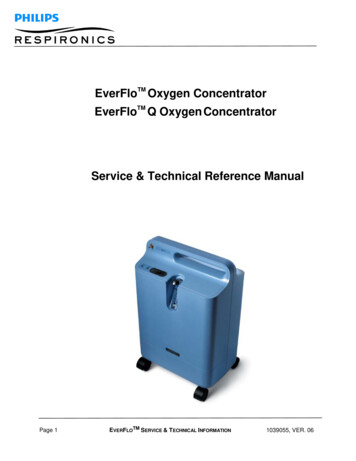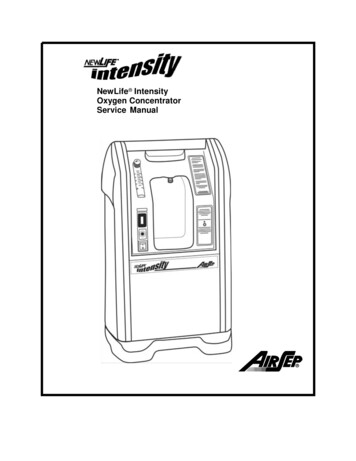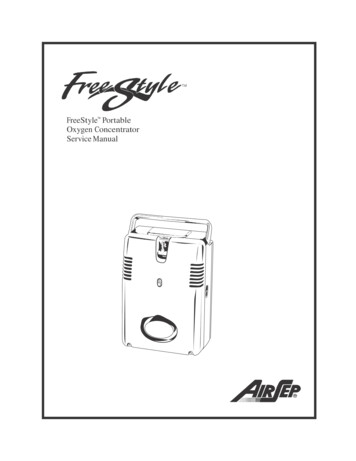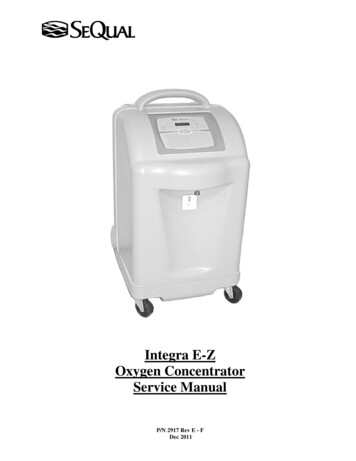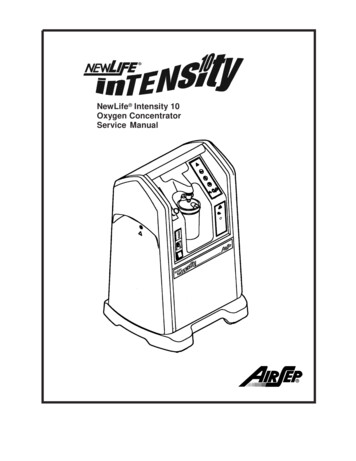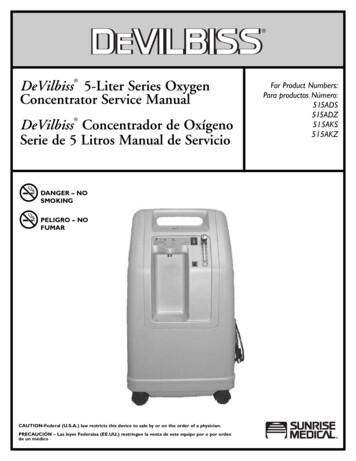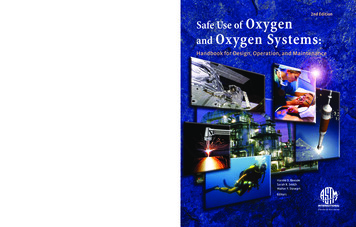
Transcription
Editors: Beeson/ Smith/ Stewart2nd EditionSafe Use of Oxygenand Oxygen Systems :Handbook for Design, Operation, and MaintenanceSafe Use of Oxygen and Oxygen Systems:Handbook for Design, Operation, and MaintenanceISBN: 978-0-8031-4470-5STOCK #: MNL36-2NDASTM INTERNATIONALwww.astm.orgHarold D. BeesonSarah R. SmithWalter F. StewartEditors
Safe Use of Oxygen and Oxygen Systems:Handbook for Design, Operation, andMaintenanceSecond EditionHarold D. BeesonSarah R. SmithWalter F. StewartEditorsASTM Stock Number: MNL36—2ndASTM International100 Barr Harbor DrivePO Box C700West Conshohocken, PA 19428-2959Printed in the U.S.A.
iiLibrary of Congress Cataloging-in-Publication DataBeeson, Harold Deck.Safe use of oxygen and oxygen systems: handbook for design, operation, and maintenance — 2nd. ed. /Harold D. Beeson, Sarah R. Smith.p. cm.Includes index.ISBN 978-0-8031-4470-51. Oxygen—Industrial applications—Equipment and supplies—Handbooks,manuals, etc. I. Smith, Sarah R. II. Title.TH9446.O95B44 2007665.8 230289—dc222007022960First edition: Handbook for oxygen system design, operation, and maintenanceCopyright 2007 AMERICAN SOCIETY FOR TESTING AND MATERIALS, West Conshohocken, PA.All rights reserved. This material may not be reproduced or copied, in whole or in part, in any printed,mechanical, electronic, film, or other distribution and storage media, without the written consent of thepublisher.Photocopy RightsAuthorization to photocopy items for internal, personal, or educational classroom use, or theinternal, personal, or educational classroom use of specific clients, is granted by the AmericanSociety for Testing and Materials (ASTM) provided that the appropriate fee is paid to theCopyright Clearance Center, 222 Rosewood Drive, Danvers, MA 01923; Tel: 508–750–8400;online: http://www.copyright.com/.The Society is not responsible, as a body, for the statements and opinions expressed in thispublication.October, 2007Baltimore, MD
iiiForewordThis edition of THE SAFE USE OF OXYGEN AND OXYGEN SYSTEMS is sponsored by Committee G4 onCompatibility and Sensitivity of Materials in Oxygen-Enriched Atmospheres. The editorial andreview work for this edition were coordinated by Sarah R. Smith, NASA Johnson Space CenterWhite Sands Test Facility, Las Cruces, New Mexico.This edition of the handbook is an extensive revision of the original ASTM Manual 36. Thisrevision includes large structural changes in the document as well as updates to the information and data contained herein.This manual contains minimum guidelines; users are encouraged to assess their individualprograms and develop additional requirements, as needed.“Shalls” and “wills” denote requirements that are mandated by other existing documents,which are referenced.
vAcknowledgmentsThe original material was contained in the NASA Safety Standard for Oxygen and Oxygen Systems, NSS 1740.15,which established a uniform NASA process for oxygen system design, materials selection, operation, storage, andtransportation. The NASA document represented a wealth of information, knowledge, and experience gained byNASA and its contractors. This information, knowledge, and experience should be extremely valuable to industry,particularly the small or infrequent user of oxygen who has little or no experience and staff to draw upon.The NASA Oxygen Safety Handbook was originally prepared under NASA contract by Paul M. Ordin, Consulting Engineer. The support of the NASA Hydrogen-Oxygen Safety Standards Review Committee in providing technical monitoring of the original standard is recognized. The Committee included the following members:William J. Brown—NASA Lewis Research CenterFrank J. Benz—NASA Johnson Space CenterMike Pedley—NASA Johnson Space CenterDennis Griffin—NASA Marshall Space Flight CenterColeman J. Bryan—NASA Kennedy Space CenterWayne Thomas—NASA Lewis Research CenterWayne Frazier—NASA HeadquartersThe editors also gratefully acknowledge the special contributions of Grace B. Ordin for aiding the preliminaryreview, organizing the material, and editing the original drafts, and William A. Price of Vitro Corporation for inputinto the original standard. The NASA Oxygen Safety Handbook was prepared and edited by personnel at the NASAJohnson Space Center White Sands Test Facility. Specific contributors include: David Hirsch, Jan Goldberg, ElliotForsyth, Mike Shoffstall, Mohan Gunaji, Rollin Christianson, Richard Shelley, Subhasish Sircar, Larry Bamford,Jim Williams, Jack Stradling, and Joel Stoltzfus. The expertise of these professionals in the area of oxygen systemhazards, design, and operation is gratefully acknowledged.The support of NASA Headquarters, Office of Safety and Mission Assurance, and specifically the support ofWayne Frazier and Claude Smith is gratefully acknowledged.The sponsoring committee for this manual is ASTM G4 on Compatibility and Sensitivity of Materials in Oxygen-Enriched Atmospheres. The committee chairman is Joseph Slusser. The oxygen manual review taskgroup consisted of Alain Colson, Barry Newton, Bob Zawierucha, Eddie Davis, Elliot Forsyth, Herve Barthelemy, Jake Jacobs,Joe Million, Joe Slusser, Kim Dunleavy, Lee Birch, Mike Shoffstall, Michael Slockers, Gwenael Chiffoleau, JohnSomavarapu, Steve Herald, Joel Stoltzfus, and Ting Chou. The work of these individuals is gratefully acknowledged.
viiContentsForeword . . . . . . . . . . . . . . . . . . . . . . . . . . . . . . . . . . . . . . . . . . . . . . . . . . . . . . . . . . . . . iiiAcknowledgments . . . . . . . . . . . . . . . . . . . . . . . . . . . . . . . . . . . . . . . . . . . . . . . . . . . . . . vFigures . . . . . . . . . . . . . . . . . . . . . . . . . . . . . . . . . . . . . . . . . . . . . . . . . . . . . . . . . . . . . . . ixTables . . . . . . . . . . . . . . . . . . . . . . . . . . . . . . . . . . . . . . . . . . . . . . . . . . . . . . . . . . . . . . . . xNomenclature . . . . . . . . . . . . . . . . . . . . . . . . . . . . . . . . . . . . . . . . . . . . . . . . . . . . . . . . . xiTrademarks . . . . . . . . . . . . . . . . . . . . . . . . . . . . . . . . . . . . . . . . . . . . . . . . . . . . . . . . . . xiiiIntroduction . . . . . . . . . . . . . . . . . . . . . . . . . . . . . . . . . . . . . . . . . . . . . . . . . . . . . . . . . . . 1Chapter 1—Basic Oxygen Safety Guidelines . . . . . . . . . . . . . . . . . . . . . . . . . . . . . . . . . 3Introduction . . . . . . . . . . . . . . . . . . . . . . . . . . . . . . . . . . . . . . . . . . . . . . . . . . . . . . . . . . .Basic Principles for the Safe Use of Oxygen . . . . . . . . . . . . . . . . . . . . . . . . . . . . . . . . . .Oxygen Handling Hazards . . . . . . . . . . . . . . . . . . . . . . . . . . . . . . . . . . . . . . . . . . . . . . .Oxygen Purity . . . . . . . . . . . . . . . . . . . . . . . . . . . . . . . . . . . . . . . . . . . . . . . . . . . . . . . . . .Importance of Cleaning Oxygen System and Components . . . . . . . . . . . . . . . . . . . . .Personnel Training . . . . . . . . . . . . . . . . . . . . . . . . . . . . . . . . . . . . . . . . . . . . . . . . . . . . . .Personal Protective Equipment . . . . . . . . . . . . . . . . . . . . . . . . . . . . . . . . . . . . . . . . . . . .Warning Systems and Controls . . . . . . . . . . . . . . . . . . . . . . . . . . . . . . . . . . . . . . . . . . . .Safety Reviews . . . . . . . . . . . . . . . . . . . . . . . . . . . . . . . . . . . . . . . . . . . . . . . . . . . . . . . . .Organizational Policies and Procedures . . . . . . . . . . . . . . . . . . . . . . . . . . . . . . . . . . . . .Emergencies . . . . . . . . . . . . . . . . . . . . . . . . . . . . . . . . . . . . . . . . . . . . . . . . . . . . . . . . . . .33344455566Chapter 2—Oxygen System Ignition Mechanisms . . . . . . . . . . . . . . . . . . . . . . . . . . . . 9Introduction . . . . . . . . . . . . . . . . . . . . . . . . . . . . . . . . . . . . . . . . . . . . . . . . . . . . . . . . . . . 9Ignition Mechanisms . . . . . . . . . . . . . . . . . . . . . . . . . . . . . . . . . . . . . . . . . . . . . . . . . . . . . 9Chapter 3—Materials Information Related to Flammability,Ignition, and Combustion . . . . . . . . . . . . . . . . . . . . . . . . . . . . . . . . . . . . . . . . . . . . . . . 16Introduction . . . . . . . . . . . . . . . . . . . . . . . . . . . . . . . . . . . . . . . . . . . . . . . . . . . . . . . . . .Ignition and Combustion Test Methods and Data . . . . . . . . . . . . . . . . . . . . . . . . . . . .Metallic Materials . . . . . . . . . . . . . . . . . . . . . . . . . . . . . . . . . . . . . . . . . . . . . . . . . . . . . .Nonmetallic Materials . . . . . . . . . . . . . . . . . . . . . . . . . . . . . . . . . . . . . . . . . . . . . . . . . .Materials Control . . . . . . . . . . . . . . . . . . . . . . . . . . . . . . . . . . . . . . . . . . . . . . . . . . . . . .1616464950Chapter 4—Oxygen Compatibility Assessment Process . . . . . . . . . . . . . . . . . . . . . . . 53Introduction . . . . . . . . . . . . . . . . . . . . . . . . . . . . . . . . . . . . . . . . . . . . . . . . . . . . . . . . . . 53Fire Risk Management . . . . . . . . . . . . . . . . . . . . . . . . . . . . . . . . . . . . . . . . . . . . . . . . . . 53Oxygen Compatibility Assessment Process . . . . . . . . . . . . . . . . . . . . . . . . . . . . . . . . . . 53Using the Oxygen Compatibility Assessment Process to Select Materials . . . . . . . . . 55Chapter 5—Design Principles . . . . . . . . . . . . . . . . . . . . . . . . . . . . . . . . . . . . . . . . . . . . 57Introduction . . . . . . . . . . . . . . . . . . . . . . . . . . . . . . . . . . . . . . . . . . . . . . . . . . . . . . . . . . 57Design Approach . . . . . . . . . . . . . . . . . . . . . . . . . . . . . . . . . . . . . . . . . . . . . . . . . . . . . . 57Design Guidelines for Oxygen Systems . . . . . . . . . . . . . . . . . . . . . . . . . . . . . . . . . . . . . 58Chapter 6—Cleaning . . . . . . . . . . . . . . . . . . . . . . . . . . . . . . . . . . . . . . . . . . . . . . . . . . . 76Introduction . . . . . . . . . . . . . . . . . . . . . . . . . . . . . . . . . . . . . . . . . . . . . . . . . . . . . . . . . .General . . . . . . . . . . . . . . . . . . . . . . . . . . . . . . . . . . . . . . . . . . . . . . . . . . . . . . . . . . . . . .Cleanliness Levels . . . . . . . . . . . . . . . . . . . . . . . . . . . . . . . . . . . . . . . . . . . . . . . . . . . . . .Cleaning Safety . . . . . . . . . . . . . . . . . . . . . . . . . . . . . . . . . . . . . . . . . . . . . . . . . . . . . . . .Cleaning Methods and Aids . . . . . . . . . . . . . . . . . . . . . . . . . . . . . . . . . . . . . . . . . . . . . .Cleaning Procedures . . . . . . . . . . . . . . . . . . . . . . . . . . . . . . . . . . . . . . . . . . . . . . . . . . . .Typical Cleaning of Specific Materials . . . . . . . . . . . . . . . . . . . . . . . . . . . . . . . . . . . . . .Clean Assembly of Oxygen Systems . . . . . . . . . . . . . . . . . . . . . . . . . . . . . . . . . . . . . . . .Maintaining the Cleanliness of Oxygen Systems . . . . . . . . . . . . . . . . . . . . . . . . . . . . .767676777781848486
viiiCONTENTSChapter 7—Operating Procedures . . . . . . . . . . . . . . . . . . . . . . . . . . . . . . . . . . . . . . . . 87Introduction . . . . . . . . . . . . . . . . . . . . . . . . . . . . . . . . . . . . . . . . . . . . . . . . . . . . . . . . . .Personnel . . . . . . . . . . . . . . . . . . . . . . . . . . . . . . . . . . . . . . . . . . . . . . . . . . . . . . . . . . . .Cooldown and Loading Procedures . . . . . . . . . . . . . . . . . . . . . . . . . . . . . . . . . . . . . . .Examinations . . . . . . . . . . . . . . . . . . . . . . . . . . . . . . . . . . . . . . . . . . . . . . . . . . . . . . . . . .Good Practices . . . . . . . . . . . . . . . . . . . . . . . . . . . . . . . . . . . . . . . . . . . . . . . . . . . . . . . . .8787878888Chapter 8—Facility Planning and Implementation . . . . . . . . . . . . . . . . . . . . . . . . . . . 89Introduction . . . . . . . . . . . . . . . . . . . . . . . . . . . . . . . . . . . . . . . . . . . . . . . . . . . . . . . . . . 89Hazards Assessment . . . . . . . . . . . . . . . . . . . . . . . . . . . . . . . . . . . . . . . . . . . . . . . . . . . . 89General Facility Guidelines . . . . . . . . . . . . . . . . . . . . . . . . . . . . . . . . . . . . . . . . . . . . . . . 89Quantity-Distance Guidelines . . . . . . . . . . . . . . . . . . . . . . . . . . . . . . . . . . . . . . . . . . . . 90Storage Systems . . . . . . . . . . . . . . . . . . . . . . . . . . . . . . . . . . . . . . . . . . . . . . . . . . . . . . . 92Storage and Handling of Compressed Gas Cylinders . . . . . . . . . . . . . . . . . . . . . . . . . . 95Storage and Handling of LOX Cylinders . . . . . . . . . . . . . . . . . . . . . . . . . . . . . . . . . . . . 96Venting and Disposal Systems . . . . . . . . . . . . . . . . . . . . . . . . . . . . . . . . . . . . . . . . . . . . 96Oxygen Detection . . . . . . . . . . . . . . . . . . . . . . . . . . . . . . . . . . . . . . . . . . . . . . . . . . . . . . 97Fire Protection Systems for Oxygen-Enriched Environments . . . . . . . . . . . . . . . . . . . . 97Facility Inspection . . . . . . . . . . . . . . . . . . . . . . . . . . . . . . . . . . . . . . . . . . . . . . . . . . . . . . 99Facility Testing, Certification, and Recertification . . . . . . . . . . . . . . . . . . . . . . . . . . . . 99Facility Maintenance . . . . . . . . . . . . . . . . . . . . . . . . . . . . . . . . . . . . . . . . . . . . . . . . . . . . 99Facility Repairs, Modifications, and Decommissioning . . . . . . . . . . . . . . . . . . . . . . . . 99Chapter 9—Transportation . . . . . . . . . . . . . . . . . . . . . . . . . . . . . . . . . . . . . . . . . . . . . 101Standards and Guidelines . . . . . . . . . . . . . . . . . . . . . . . . . . . . . . . . . . . . . . . . . . . . . . . 101Transport on Public Thoroughfares . . . . . . . . . . . . . . . . . . . . . . . . . . . . . . . . . . . . . .
This edition of the handbook is an extensive revision of the original ASTM Manual 36. This revision includes large structural changes in the document as well as updates to the informa-tion and data contained herein. This manual contains minimum guidelines; users
